Foto Pesce was an Italian photo studio that portrayed many Italian film stars of the late 1930 and early 1940s. Foto Pesce was a photographic agency founded in 1916 by Aurelio Pesce. Pesce's glamorous portraits were used for the postcards of such publishers as Rizzoli, Ballerini & Fratini (B.F.F.), and A. Scarmiglia (ASER). These portraits were often made for Scalera Film.
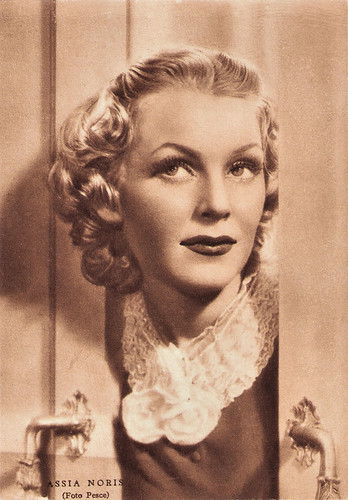
Italian postcard by Rizzoli EC., Milano, 1938-XVI. Photo: Foto Pesce. Assia Noris.
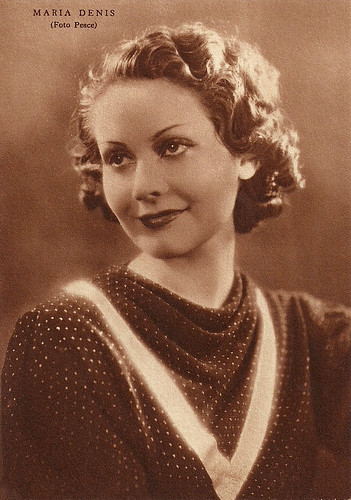
Italian postcard by Rizzoli, Milano, 1938. Photo: Foto Pesce. Maria Denis.

Italian postcard by Rizzoli, Milano, 1939. Photo: Foto Pesce. Isa Pola.

Italian postcard by Rizzoli, Milano, 1942. Photo: Foto Pesce. Valentina Cortese as Lisabetta in La cena delle beffe/The Jester's Supper (Alessandro Blasetti, 1942).

Italian postcard by Rizzoli, Milano. Photo: Foto Pesce. Annie Vernay in La principessa Tarakanova/Princess Tarakanova (Fyodor Otsep as Fedor Ozep, Mario Soldati, 1938)
Aurelio Pesce was born in Naples in 1885. After moving to Rome, he established himself as a portrait photographer by opening a studio in Via dei Condotti 9, around 1916. His brother Franco Pesce joined him, albeit sporadically, as coadjutor.
Appointed head of the photographic department of Cines-Pittaluga, Aurelio left his studio in 1930. His photographs and portraits have been taken as models by other photographers for more than a decade.
In 1934 his brother Ettore Pesce began to work alongside him. The fire in the factories of Cines-Pittaluga in 1935, forced the productions to move to Turin and the Tirrenia studio. Aurelio also moved, while maintaining a photographic department at Cines, for which he remained responsible.
In 1936 Aurelio also called with him his young stepbrother Sergio Pesce, who established himself as a stage photographer in 1938. At the birth of Cinecittà in 1937, Aurelio left the responsibility of the photographic department, first, to his brother Ettore and then to Osvaldo Civirani.
In 1938, Aurelio became the official photographer of Scalera Film. He later founded his own photographic laboratory in Via Marco Tabarrini, in Rome where Pesce, Civirani, and Tosoni would create the first cinematic backdrop for the film La Principessa Tarakanova/Princess Tarakanova (Fyodor Otsep (as Fedor Ozep), Mario Soldati, 1938) starring Annie Vernay, printed and developed in one night.
After the war, the 'Foto Pesce' brand became 'Ettore Pesce' and 'Pesce Benfari'. Unlike Aurelio and Ettore, the other two brothers, Franco and Sergio, continued their career taking different paths from still photography. Franco was dedicated to the management of photography and after the war, he began his acting career. Sergio first worked as an assistant and cameraman for Scalera Film, assisting Ubaldo Arata, and later he established himself as director of photography.
Among the films that the Pesce brothers worked on are photos of: Nerone/Nero (1930), Terra madre/Mother Earth (1931) with Leda Gloria, Palio/The Palio of Siena (1932), 1860 (1933), Aldebaran (1935) starring Gino Cervi, and Un'avventura di Salvator Rosa/An adventure of Salvator Rosa (1939), all directed by Alessandro Blasetti, Che gioia vivere/What a joy live (René Clément, 1961) with Alain Delon, Abbasso la miseria!/Down with misery! (Gennaro Righelli, 1945) with Anna Magnani, Molti sogni per le strade/Many dreams on the streets (Mario Camerini, 1945) with Aurelio Pesce as the cameraman, and L'onorevole Angelina/Angelina (Luigi Zampa, 1947) with Ettore Pesce as the cameraman.

Italian postcard by Ballerini & Fratini, Firenze, Editori (B.F.F. Edit.), no. 2150. Photo Pesce / ENIC. Massimo Girotti in La corona di ferro/The Iron Crown (Alessandro Blasetti, 1941).
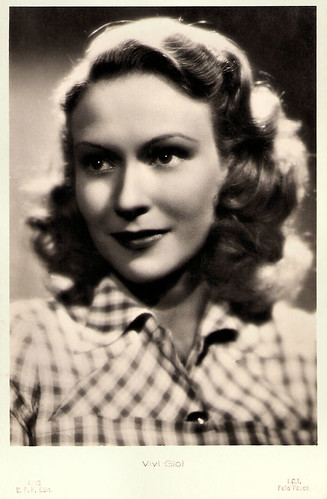
Italian postcard by Ballerini & Fratini, Firenze, Editori (B.F.F. Edit.), no. 4223. Photo: Pesce / I.C.I. Vivi Gioi.
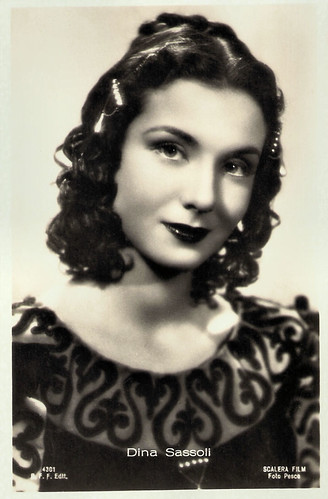
Italian postcard by Ballerini & Fratini, Firenze, Editori (B.F.F. Edit.), no. 4301. Photo: Foto Pesce / Scalera Film. Dina Sassoli in Don Giovanni/Loves of Don Juan (Dino Falconi, 1942).

Italian postcard by Ballerini & Fratini, Firenze, Editori (B.F.F. Edit.), no. 4304. Photo: Foto Pesce / Scalera Film. Elli Parvo's outfit is that of I due Foscari (1942).

Italian postcard by Ballerini & Fratini, Firenze, Editori (B.F.F. Edit.), no. 4446-A. Photo: Foto Pesce / E.N.I.C. Vivi Gioi.

Italian postcard by Ballerini & Fratini, Firenze, Editori (B.F.F. Edit.), no. 4452-A. Photo: Foto Pesce / Scalera Film. Carlo Ninchi in Giarabub (Goffredo Alessandrini, 1942).

Italian postcard by Ballerini & Fratini, Firenze, Editori (B.F.F. Edit.), no. 4457. Photo: Foto Pesce / Scalera Film. Fosco Giachetti in Noi Vivi/We the Living (Goffredo Alessandrini, 1942), an adaptation of the novel 'We the Living' by Ayn Rand.
During the late 1930s, Pesce often worked for Scalera Film, an Italian film production and distribution company that operated between 1938 and 1950.
Scalera had strong backing from the Italian state, as the Fascist government of Benito Mussolini was keen to build up and centralise the Italian film industry.
Scalera Studios was based in Rome, but in 1943 during the German occupation of Rome, the studio was relocated to Venice in the Italian Social Republic as part of a planned Cinevillaggio film complex developed by Mussolini loyalists.
However, after 1942 there are no postcards with photos by Pesce known.

Italian postcard by ASER (A. Scarmiglia Edizioni, Roma), no. 33. Photo: Pesce / Scalera Film. Carlo Ninchi.

Italian postcard by ASER, no. 80. Photo Pesce / Scalera Film. Annibale Betrone as count Ranieri in the perod piece La Gorgona (Guido Brignone, 1942).
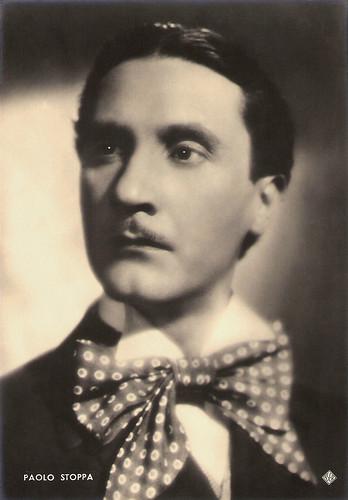
Italian postcard by ASER, no. 96. Photo: Pesce. Paolo Stoppa.
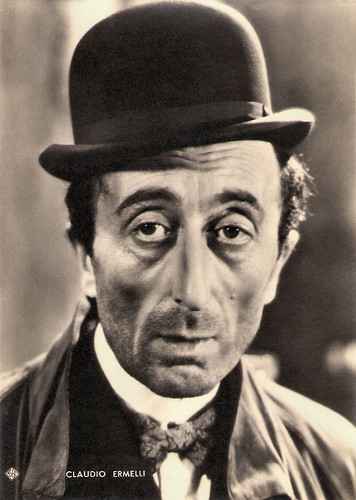
Italian postcard by ASER, no. 97. Photo: Pesce. Claudio Ermelli

Italian postcard by ASER, no. 224. Photo: Pesce / Scalera Film. Alida Valli and Rossano Brazzi in Noi Vivi/We the Living (Goffredo Alessandrini, 1942).
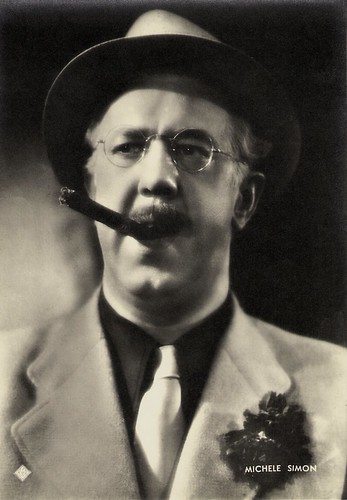
Italian postcard by ASER. Photo: Pesce. Michel Simon in Comédie du bonheur/Comedy of Happiness (Marcel L'Herbier, 1940).

Italian postcard by Hector, no. 2.20, 1941. Photo: Pesce / Scalera Film. Isa Pola in Lucrezia Borgia (Hans Hinrich, 1940).

Italian postcard by Armando Terzoli, Roma, no. 221. Photo: Pesce. Laura Nucci in La Signorina/The young lady (Ladislao Kish, 1942).

Italian postcard by Armando Terzoli, Roma, no. 532. Photo: Foto Pesce. Clara Calamai in La Cena delle Beffe/The Jesters' Supper (Alessandro Blasetti, 1942).
Sources: Sentieri selvaggi (Italian), and Wikipedia.
Rizzoli

Italian postcard by Rizzoli EC., Milano, 1938-XVI. Photo: Foto Pesce. Assia Noris.

Italian postcard by Rizzoli, Milano, 1938. Photo: Foto Pesce. Maria Denis.

Italian postcard by Rizzoli, Milano, 1939. Photo: Foto Pesce. Isa Pola.

Italian postcard by Rizzoli, Milano, 1942. Photo: Foto Pesce. Valentina Cortese as Lisabetta in La cena delle beffe/The Jester's Supper (Alessandro Blasetti, 1942).

Italian postcard by Rizzoli, Milano. Photo: Foto Pesce. Annie Vernay in La principessa Tarakanova/Princess Tarakanova (Fyodor Otsep as Fedor Ozep, Mario Soldati, 1938)
The four Pesce brothers
Aurelio Pesce was born in Naples in 1885. After moving to Rome, he established himself as a portrait photographer by opening a studio in Via dei Condotti 9, around 1916. His brother Franco Pesce joined him, albeit sporadically, as coadjutor.
Appointed head of the photographic department of Cines-Pittaluga, Aurelio left his studio in 1930. His photographs and portraits have been taken as models by other photographers for more than a decade.
In 1934 his brother Ettore Pesce began to work alongside him. The fire in the factories of Cines-Pittaluga in 1935, forced the productions to move to Turin and the Tirrenia studio. Aurelio also moved, while maintaining a photographic department at Cines, for which he remained responsible.
In 1936 Aurelio also called with him his young stepbrother Sergio Pesce, who established himself as a stage photographer in 1938. At the birth of Cinecittà in 1937, Aurelio left the responsibility of the photographic department, first, to his brother Ettore and then to Osvaldo Civirani.
In 1938, Aurelio became the official photographer of Scalera Film. He later founded his own photographic laboratory in Via Marco Tabarrini, in Rome where Pesce, Civirani, and Tosoni would create the first cinematic backdrop for the film La Principessa Tarakanova/Princess Tarakanova (Fyodor Otsep (as Fedor Ozep), Mario Soldati, 1938) starring Annie Vernay, printed and developed in one night.
After the war, the 'Foto Pesce' brand became 'Ettore Pesce' and 'Pesce Benfari'. Unlike Aurelio and Ettore, the other two brothers, Franco and Sergio, continued their career taking different paths from still photography. Franco was dedicated to the management of photography and after the war, he began his acting career. Sergio first worked as an assistant and cameraman for Scalera Film, assisting Ubaldo Arata, and later he established himself as director of photography.
Among the films that the Pesce brothers worked on are photos of: Nerone/Nero (1930), Terra madre/Mother Earth (1931) with Leda Gloria, Palio/The Palio of Siena (1932), 1860 (1933), Aldebaran (1935) starring Gino Cervi, and Un'avventura di Salvator Rosa/An adventure of Salvator Rosa (1939), all directed by Alessandro Blasetti, Che gioia vivere/What a joy live (René Clément, 1961) with Alain Delon, Abbasso la miseria!/Down with misery! (Gennaro Righelli, 1945) with Anna Magnani, Molti sogni per le strade/Many dreams on the streets (Mario Camerini, 1945) with Aurelio Pesce as the cameraman, and L'onorevole Angelina/Angelina (Luigi Zampa, 1947) with Ettore Pesce as the cameraman.
Ballerini & Fratini

Italian postcard by Ballerini & Fratini, Firenze, Editori (B.F.F. Edit.), no. 2150. Photo Pesce / ENIC. Massimo Girotti in La corona di ferro/The Iron Crown (Alessandro Blasetti, 1941).

Italian postcard by Ballerini & Fratini, Firenze, Editori (B.F.F. Edit.), no. 4223. Photo: Pesce / I.C.I. Vivi Gioi.

Italian postcard by Ballerini & Fratini, Firenze, Editori (B.F.F. Edit.), no. 4301. Photo: Foto Pesce / Scalera Film. Dina Sassoli in Don Giovanni/Loves of Don Juan (Dino Falconi, 1942).

Italian postcard by Ballerini & Fratini, Firenze, Editori (B.F.F. Edit.), no. 4304. Photo: Foto Pesce / Scalera Film. Elli Parvo's outfit is that of I due Foscari (1942).

Italian postcard by Ballerini & Fratini, Firenze, Editori (B.F.F. Edit.), no. 4446-A. Photo: Foto Pesce / E.N.I.C. Vivi Gioi.

Italian postcard by Ballerini & Fratini, Firenze, Editori (B.F.F. Edit.), no. 4452-A. Photo: Foto Pesce / Scalera Film. Carlo Ninchi in Giarabub (Goffredo Alessandrini, 1942).

Italian postcard by Ballerini & Fratini, Firenze, Editori (B.F.F. Edit.), no. 4457. Photo: Foto Pesce / Scalera Film. Fosco Giachetti in Noi Vivi/We the Living (Goffredo Alessandrini, 1942), an adaptation of the novel 'We the Living' by Ayn Rand.
Scalera Film
During the late 1930s, Pesce often worked for Scalera Film, an Italian film production and distribution company that operated between 1938 and 1950.
Scalera had strong backing from the Italian state, as the Fascist government of Benito Mussolini was keen to build up and centralise the Italian film industry.
Scalera Studios was based in Rome, but in 1943 during the German occupation of Rome, the studio was relocated to Venice in the Italian Social Republic as part of a planned Cinevillaggio film complex developed by Mussolini loyalists.
However, after 1942 there are no postcards with photos by Pesce known.
ASER

Italian postcard by ASER (A. Scarmiglia Edizioni, Roma), no. 33. Photo: Pesce / Scalera Film. Carlo Ninchi.

Italian postcard by ASER, no. 80. Photo Pesce / Scalera Film. Annibale Betrone as count Ranieri in the perod piece La Gorgona (Guido Brignone, 1942).

Italian postcard by ASER, no. 96. Photo: Pesce. Paolo Stoppa.

Italian postcard by ASER, no. 97. Photo: Pesce. Claudio Ermelli

Italian postcard by ASER, no. 224. Photo: Pesce / Scalera Film. Alida Valli and Rossano Brazzi in Noi Vivi/We the Living (Goffredo Alessandrini, 1942).

Italian postcard by ASER. Photo: Pesce. Michel Simon in Comédie du bonheur/Comedy of Happiness (Marcel L'Herbier, 1940).

Italian postcard by Hector, no. 2.20, 1941. Photo: Pesce / Scalera Film. Isa Pola in Lucrezia Borgia (Hans Hinrich, 1940).

Italian postcard by Armando Terzoli, Roma, no. 221. Photo: Pesce. Laura Nucci in La Signorina/The young lady (Ladislao Kish, 1942).

Italian postcard by Armando Terzoli, Roma, no. 532. Photo: Foto Pesce. Clara Calamai in La Cena delle Beffe/The Jesters' Supper (Alessandro Blasetti, 1942).
Sources: Sentieri selvaggi (Italian), and Wikipedia.
No comments:
Post a Comment